2001 INFINITI QX4 Battery terminal
[x] Cancel search: Battery terminalPage 1251 of 2395
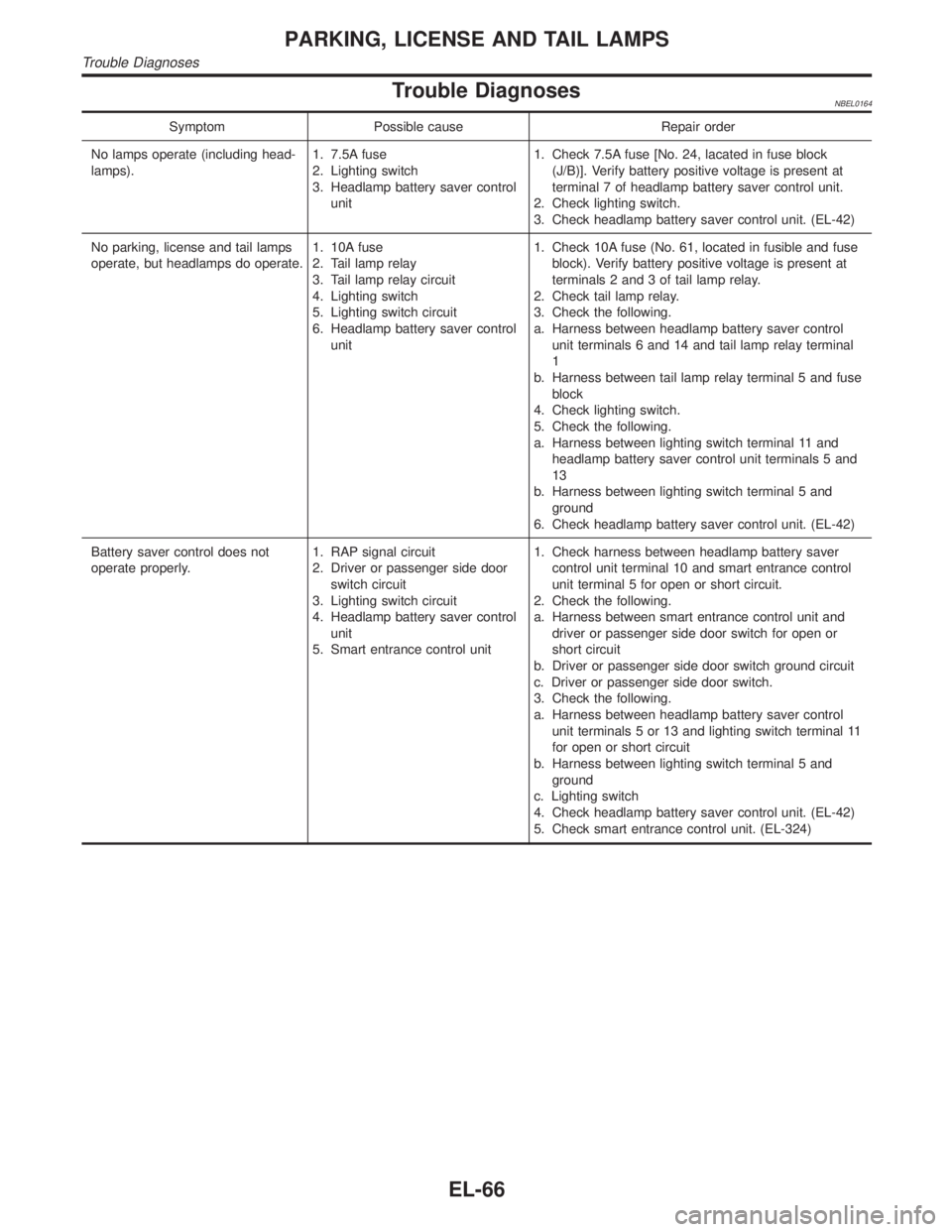
Trouble DiagnosesNBEL0164
Symptom Possible cause Repair order
No lamps operate (including head-
lamps).1. 7.5A fuse
2. Lighting switch
3. Headlamp battery saver control
unit1. Check 7.5A fuse [No. 24, lacated in fuse block
(J/B)]. Verify battery positive voltage is present at
terminal 7 of headlamp battery saver control unit.
2. Check lighting switch.
3. Check headlamp battery saver control unit. (EL-42)
No parking, license and tail lamps
operate, but headlamps do operate.1. 10A fuse
2. Tail lamp relay
3. Tail lamp relay circuit
4. Lighting switch
5. Lighting switch circuit
6. Headlamp battery saver control
unit1. Check 10A fuse (No. 61, located in fusible and fuse
block). Verify battery positive voltage is present at
terminals 2 and 3 of tail lamp relay.
2. Check tail lamp relay.
3. Check the following.
a. Harness between headlamp battery saver control
unit terminals 6 and 14 and tail lamp relay terminal
1
b. Harness between tail lamp relay terminal 5 and fuse
block
4. Check lighting switch.
5. Check the following.
a. Harness between lighting switch terminal 11 and
headlamp battery saver control unit terminals 5 and
13
b. Harness between lighting switch terminal 5 and
ground
6. Check headlamp battery saver control unit. (EL-42)
Battery saver control does not
operate properly.1. RAP signal circuit
2. Driver or passenger side door
switch circuit
3. Lighting switch circuit
4. Headlamp battery saver control
unit
5. Smart entrance control unit1. Check harness between headlamp battery saver
control unit terminal 10 and smart entrance control
unit terminal 5 for open or short circuit.
2. Check the following.
a. Harness between smart entrance control unit and
driver or passenger side door switch for open or
short circuit
b. Driver or passenger side door switch ground circuit
c. Driver or passenger side door switch.
3. Check the following.
a. Harness between headlamp battery saver control
unit terminals 5 or 13 and lighting switch terminal 11
for open or short circuit
b. Harness between lighting switch terminal 5 and
ground
c. Lighting switch
4. Check headlamp battery saver control unit. (EL-42)
5. Check smart entrance control unit. (EL-324)
PARKING, LICENSE AND TAIL LAMPS
Trouble Diagnoses
EL-66
Page 1255 of 2395

System DescriptionNBEL0027OUTLINENBEL0027S02Power is supplied at all times
Ito headlamp RH relay terminals 1 and 3
Ithrough 15A fuse (No. 59, located in the fuse and fusible link box), and
Ito headlamp battery saver control unit terminal 7
Ito smart entrance control unit terminal 10
Ithrough 7.5A fuse [No. 24, located in the fuse block (J/B)], and
Ito front fog lamp relay terminal 3
Ithrough 15A fuse (No. 53, located in the fuse and fusible link box).
When ignition switch is in ON or START position, power is supplied
Ito headlamp battery saver control unit terminal 1
Ithrough 10A fuse [No. 16, located in the fuse block (J/B)], and
Ito headlamp battery saver control unit terminal 10, and
Ito smart entrance control unit terminal 33
Ithrough 7.5A fuse [No. 11, located in the fuse block (J/B)].
Ground is supplied to headlamp battery saver control unit terminals 4 and 11.
When lighting system is in 2ND position, ground is supplied
Ito headlamp RH relay terminal 2 from headlamp battery saver control unit terminals 2 and 8
Ithrough headlamp battery saver control unit terminals 3 and 9,
Ithrough lighting switch terminal 12, and
Ithrough body grounds E13 and E41.
Headlamp RH relay is then energized.
FRONT FOG LAMP OPERATIONNBEL0027S01The front fog lamp switch is built into the combination switch. The lighting switch must be in the 2ND position
and LOW (ªBº) position for front fog lamp operation.
With the front fog lamp switch in the ON position, ground is supplied
Ito front fog lamp relay terminal 2
Ithrough the front fog lamp switch, lighting switch and body grounds E13 and E41.
The front fog lamp relay is energized and power is supplied
Ifrom front fog lamp relay terminal 5
Ito terminal 1 of each front fog lamp.
Ground is supplied to terminal 3 of each front fog lamp through body grounds E13 and E41.
With power and ground supplied, the front fog lamps illuminate.
BATTERY SAVER CONTROLNBEL0027S03When the ignition switch is turned from ON (or START) to OFF (or ACC) positions while front fog lamps are
illuminated, the RAP signal is supplied to terminal 10 of the headlamp battery saver control unit from smart
entrance control unit terminal 5.
After counting 45 seconds by the RAP signal from the smart entrance control unit to headlamp battery saver
control unit, the ground supply to terminal 2 of headlamp RH relay from headlamp battery saver control unit
teminals 2 and 8 are terminated.
Then front fog lamps are turned to off.
Front fog lamps are turned off when driver or passenger side door is opened even if 45 seconds have not
passed after the ignition switch is turned from ON (or START) to OFF (or ACC) positions while front fog lamps
are illuminated.
When the lighting switch is turned from OFF to 2ND after front fog lamps are turned off by the battery saver
control, ground is supplied
Ito headlamp battery saver control unit terminals 5 and 13 from lighting switch terminal 11, and
Ito headlamp RH relay terminal 2 from headlamp battery saver control unit terminals 2 and 8
Ithrough headlamp battery saver control unit terminals 3 and 9, and
Ithrough lighting switch terminal 12.
Then the front fog lamps illuminate again.
FRONT FOG LAMP
System Description
EL-70
Page 1264 of 2395
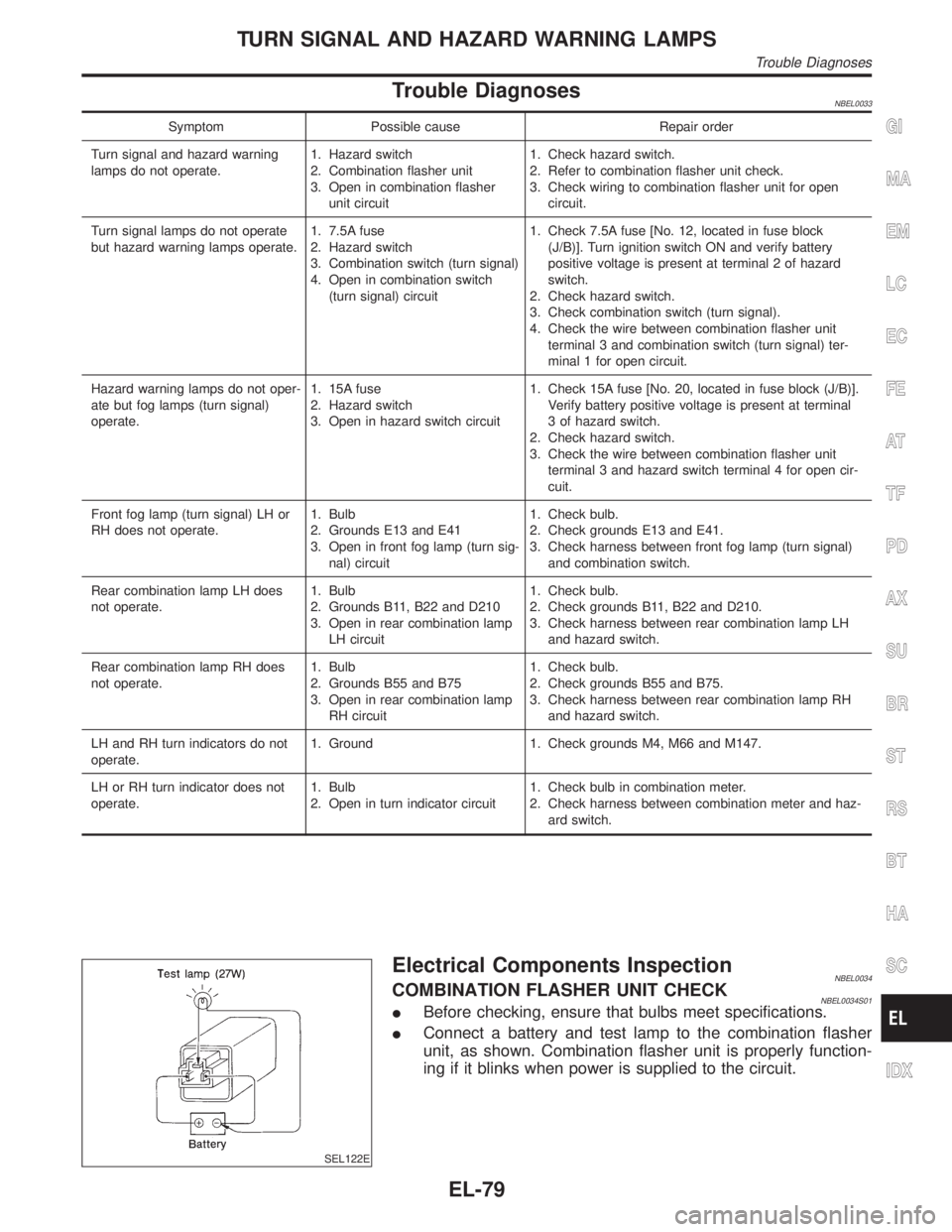
Trouble DiagnosesNBEL0033
Symptom Possible cause Repair order
Turn signal and hazard warning
lamps do not operate.1. Hazard switch
2. Combination flasher unit
3. Open in combination flasher
unit circuit1. Check hazard switch.
2. Refer to combination flasher unit check.
3. Check wiring to combination flasher unit for open
circuit.
Turn signal lamps do not operate
but hazard warning lamps operate.1. 7.5A fuse
2. Hazard switch
3. Combination switch (turn signal)
4. Open in combination switch
(turn signal) circuit1. Check 7.5A fuse [No. 12, located in fuse block
(J/B)]. Turn ignition switch ON and verify battery
positive voltage is present at terminal 2 of hazard
switch.
2. Check hazard switch.
3. Check combination switch (turn signal).
4. Check the wire between combination flasher unit
terminal 3 and combination switch (turn signal) ter-
minal 1 for open circuit.
Hazard warning lamps do not oper-
ate but fog lamps (turn signal)
operate.1. 15A fuse
2. Hazard switch
3. Open in hazard switch circuit1. Check 15A fuse [No. 20, located in fuse block (J/B)].
Verify battery positive voltage is present at terminal
3 of hazard switch.
2. Check hazard switch.
3. Check the wire between combination flasher unit
terminal 3 and hazard switch terminal 4 for open cir-
cuit.
Front fog lamp (turn signal) LH or
RH does not operate.1. Bulb
2. Grounds E13 and E41
3. Open in front fog lamp (turn sig-
nal) circuit1. Check bulb.
2. Check grounds E13 and E41.
3. Check harness between front fog lamp (turn signal)
and combination switch.
Rear combination lamp LH does
not operate.1. Bulb
2. Grounds B11, B22 and D210
3. Open in rear combination lamp
LH circuit1. Check bulb.
2. Check grounds B11, B22 and D210.
3. Check harness between rear combination lamp LH
and hazard switch.
Rear combination lamp RH does
not operate.1. Bulb
2. Grounds B55 and B75
3. Open in rear combination lamp
RH circuit1. Check bulb.
2. Check grounds B55 and B75.
3. Check harness between rear combination lamp RH
and hazard switch.
LH and RH turn indicators do not
operate.1. Ground 1. Check grounds M4, M66 and M147.
LH or RH turn indicator does not
operate.1. Bulb
2. Open in turn indicator circuit1. Check bulb in combination meter.
2. Check harness between combination meter and haz-
ard switch.
SEL122E
Electrical Components InspectionNBEL0034COMBINATION FLASHER UNIT CHECKNBEL0034S01IBefore checking, ensure that bulbs meet specifications.
IConnect a battery and test lamp to the combination flasher
unit, as shown. Combination flasher unit is properly function-
ing if it blinks when power is supplied to the circuit.
GI
MA
EM
LC
EC
FE
AT
TF
PD
AX
SU
BR
ST
RS
BT
HA
SC
IDX
TURN SIGNAL AND HAZARD WARNING LAMPS
Trouble Diagnoses
EL-79
Page 1265 of 2395

System DescriptionNBEL0035The illumination lamp operation is controlled by the lighting switch which is built into the combination switch
and headlamp battery saver control unit. The battery saver system is controlled by the headlamp battery saver
control unit and smart entrance control unit.
Power is supplied at all times
Ito tail lamp relay terminals 2 and 3
Ithrough 10A fuse (No. 61, located in the fuse and fusible link box), and
Ito headlamp battery saver control unit terminal 7, and
Ito smart entrance control unit terminal 10
Ithrough 7.5A fuse [No. 24, located in the fuse block (J/B)].
When ignition switch is in ON or START position, power is supplied
Ito headlamp battery saver control unit terminal 1
Ithrough 10A fuse [No. 16, located in the fuse block (J/B)], and
Ito headlamp battery saver control unit terminal 10, and
Ito smart entrance control unit terminal 33
Ithrough 7.5A fuse [No. 11, located in the fuse block (J/B)].
Ground is supplied to headlamp battery saver control unit terminals 4 and 11.
LIGHTING OPERATION BY LIGHTING SWITCHNBEL0035S01When lighting switch is 1ST (or 2ND) position, ground is supplied
Ito tail lamp relay terminal 1 from headlamp battery saver control unit terminals 6 and 14
Ithrough headlamp battery saver control unit terminals 5 and 13, and
Ithrough body grounds E13 and E41.
Tail lamp relay is then energized and illumination lamps illuminate.
The lighting switch must be in the 1ST or 2ND position for illumination.
LIGHTING OPERATION BY AUTO LIGHT CONTROL SYSTEMNBEL0035S03When auto light operation is operated, ground is supplied
Ito tail lamp relay terminal 1 from headlamp battery saver control unit terminals 6 and 14
Ithrough headlamp battery saver control unit terminals 5 and 13, and
Ithrough auto light control unit terminal 7.
Tail lamp relay is then energized and the illumination lamps illuminate.
The illumination control switch that controls the amount of current to the illumination system. As the amount
of current increases, the illumination becomes brighter.
The following chart shows the power and ground connector terminals for the components included in the illu-
mination system.
Component Connector No. Power terminal Ground terminal
Illumination control switch M19 1 3
4WD shift switch M141 7 8
Ashtray M54 1 2
A/T indicator B59 3 4
Cigarette lighter M57 3 4
Audio unit M48 8 7
Compass and thermometer R4 5 2
Hazard switch M35 7 8
Rear window defogger switch M36 5 6
Headlamp aiming switch M16 3 4
Power window main switch D6 16 18
Front power window switch RH D36 10 17
ILLUMINATION
System Description
EL-80
Page 1266 of 2395
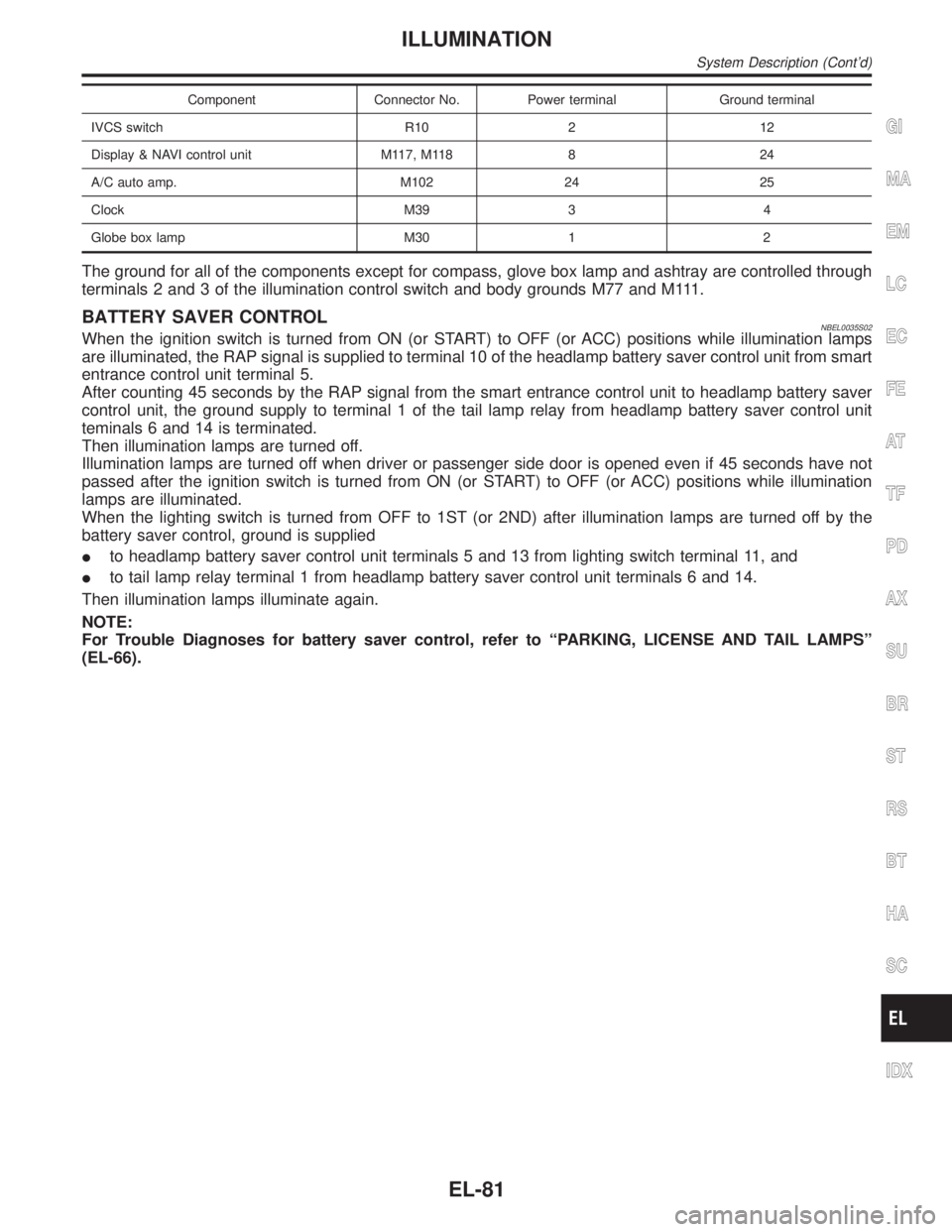
Component Connector No. Power terminal Ground terminal
IVCS switch R10 2 12
Display & NAVI control unit M117, M118 8 24
A/C auto amp. M102 24 25
Clock M39 3 4
Globe box lamp M30 1 2
The ground for all of the components except for compass, glove box lamp and ashtray are controlled through
terminals 2 and 3 of the illumination control switch and body grounds M77 and M111.
BATTERY SAVER CONTROLNBEL0035S02When the ignition switch is turned from ON (or START) to OFF (or ACC) positions while illumination lamps
are illuminated, the RAP signal is supplied to terminal 10 of the headlamp battery saver control unit from smart
entrance control unit terminal 5.
After counting 45 seconds by the RAP signal from the smart entrance control unit to headlamp battery saver
control unit, the ground supply to terminal 1 of the tail lamp relay from headlamp battery saver control unit
teminals 6 and 14 is terminated.
Then illumination lamps are turned off.
Illumination lamps are turned off when driver or passenger side door is opened even if 45 seconds have not
passed after the ignition switch is turned from ON (or START) to OFF (or ACC) positions while illumination
lamps are illuminated.
When the lighting switch is turned from OFF to 1ST (or 2ND) after illumination lamps are turned off by the
battery saver control, ground is supplied
Ito headlamp battery saver control unit terminals 5 and 13 from lighting switch terminal 11, and
Ito tail lamp relay terminal 1 from headlamp battery saver control unit terminals 6 and 14.
Then illumination lamps illuminate again.
NOTE:
For Trouble Diagnoses for battery saver control, refer to ªPARKING, LICENSE AND TAIL LAMPSº
(EL-66).
GI
MA
EM
LC
EC
FE
AT
TF
PD
AX
SU
BR
ST
RS
BT
HA
SC
IDX
ILLUMINATION
System Description (Cont'd)
EL-81
Page 1274 of 2395
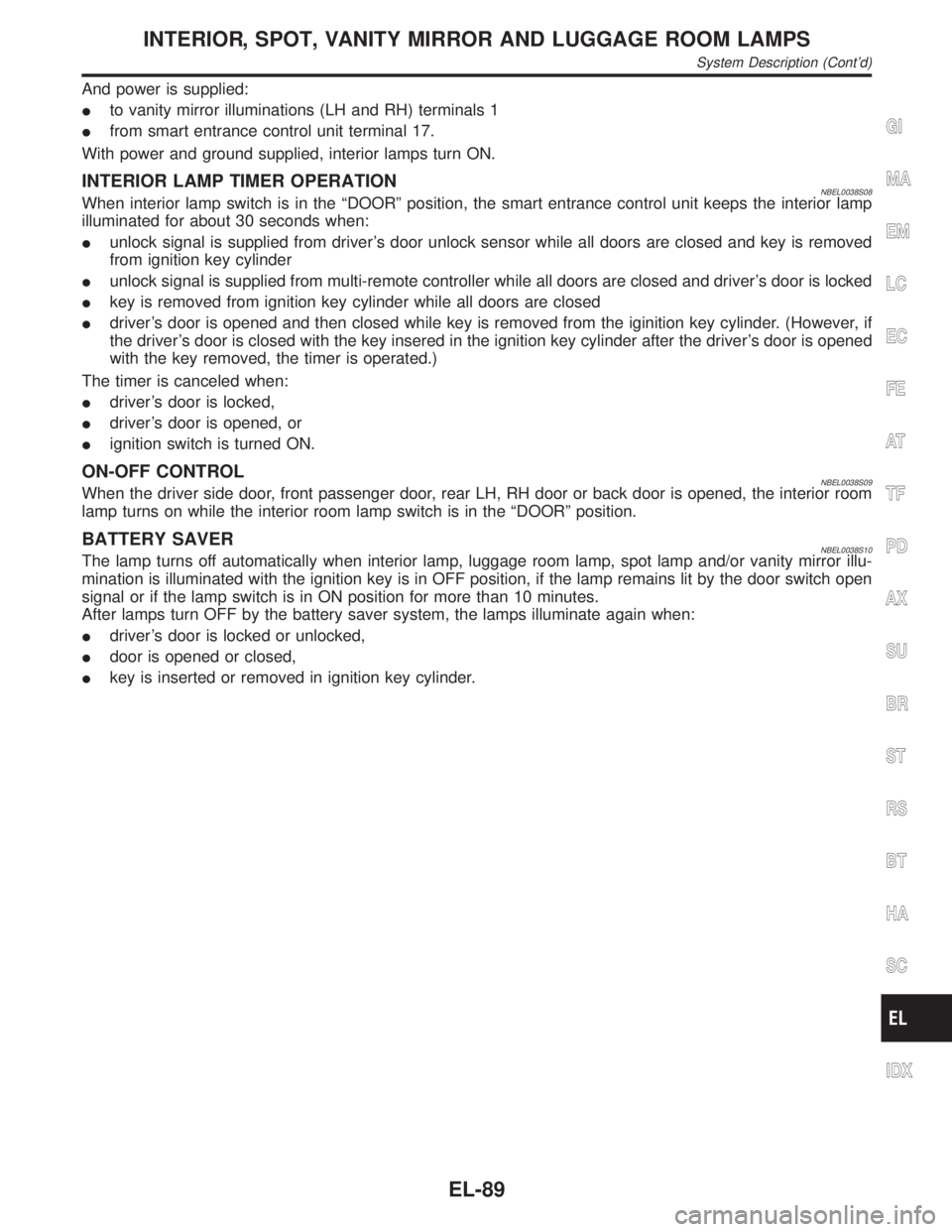
And power is supplied:
Ito vanity mirror illuminations (LH and RH) terminals 1
Ifrom smart entrance control unit terminal 17.
With power and ground supplied, interior lamps turn ON.
INTERIOR LAMP TIMER OPERATIONNBEL0038S08When interior lamp switch is in the ªDOORº position, the smart entrance control unit keeps the interior lamp
illuminated for about 30 seconds when:
Iunlock signal is supplied from driver's door unlock sensor while all doors are closed and key is removed
from ignition key cylinder
Iunlock signal is supplied from multi-remote controller while all doors are closed and driver's door is locked
Ikey is removed from ignition key cylinder while all doors are closed
Idriver's door is opened and then closed while key is removed from the iginition key cylinder. (However, if
the driver's door is closed with the key insered in the ignition key cylinder after the driver's door is opened
with the key removed, the timer is operated.)
The timer is canceled when:
Idriver's door is locked,
Idriver's door is opened, or
Iignition switch is turned ON.
ON-OFF CONTROLNBEL0038S09When the driver side door, front passenger door, rear LH, RH door or back door is opened, the interior room
lamp turns on while the interior room lamp switch is in the ªDOORº position.
BATTERY SAVERNBEL0038S10The lamp turns off automatically when interior lamp, luggage room lamp, spot lamp and/or vanity mirror illu-
mination is illuminated with the ignition key is in OFF position, if the lamp remains lit by the door switch open
signal or if the lamp switch is in ON position for more than 10 minutes.
After lamps turn OFF by the battery saver system, the lamps illuminate again when:
Idriver's door is locked or unlocked,
Idoor is opened or closed,
Ikey is inserted or removed in ignition key cylinder.
GI
MA
EM
LC
EC
FE
AT
TF
PD
AX
SU
BR
ST
RS
BT
HA
SC
IDX
INTERIOR, SPOT, VANITY MIRROR AND LUGGAGE ROOM LAMPS
System Description (Cont'd)
EL-89
Page 1288 of 2395

SEL179WB
POWER SUPPLY AND GROUND CIRCUIT CHECK=NBEL0201S03Power Supply Circuit CheckNBEL0201S0301
Terminals Ignition switch position
(+) (þ) OFF ACC ON
62 GroundBattery
voltageBattery
voltageBattery
voltage
66 Ground 0V 0VBattery
voltage
If NG, check the following.
I10A fuse [No. 12, located in fuse block (J/B)]
I10A fuse [No. 30, located in fuse block (J/B)]
IHarness for open or short between fuse and combination
meter
SEL180WA
Ground Circuit CheckNBEL0201S0302
Terminals Continuity
59 - Ground Yes
GI
MA
EM
LC
EC
FE
AT
TF
PD
AX
SU
BR
ST
RS
BT
HA
SC
IDX
METERS AND GAUGES
Trouble Diagnoses (Cont'd)
EL-103
Page 1297 of 2395
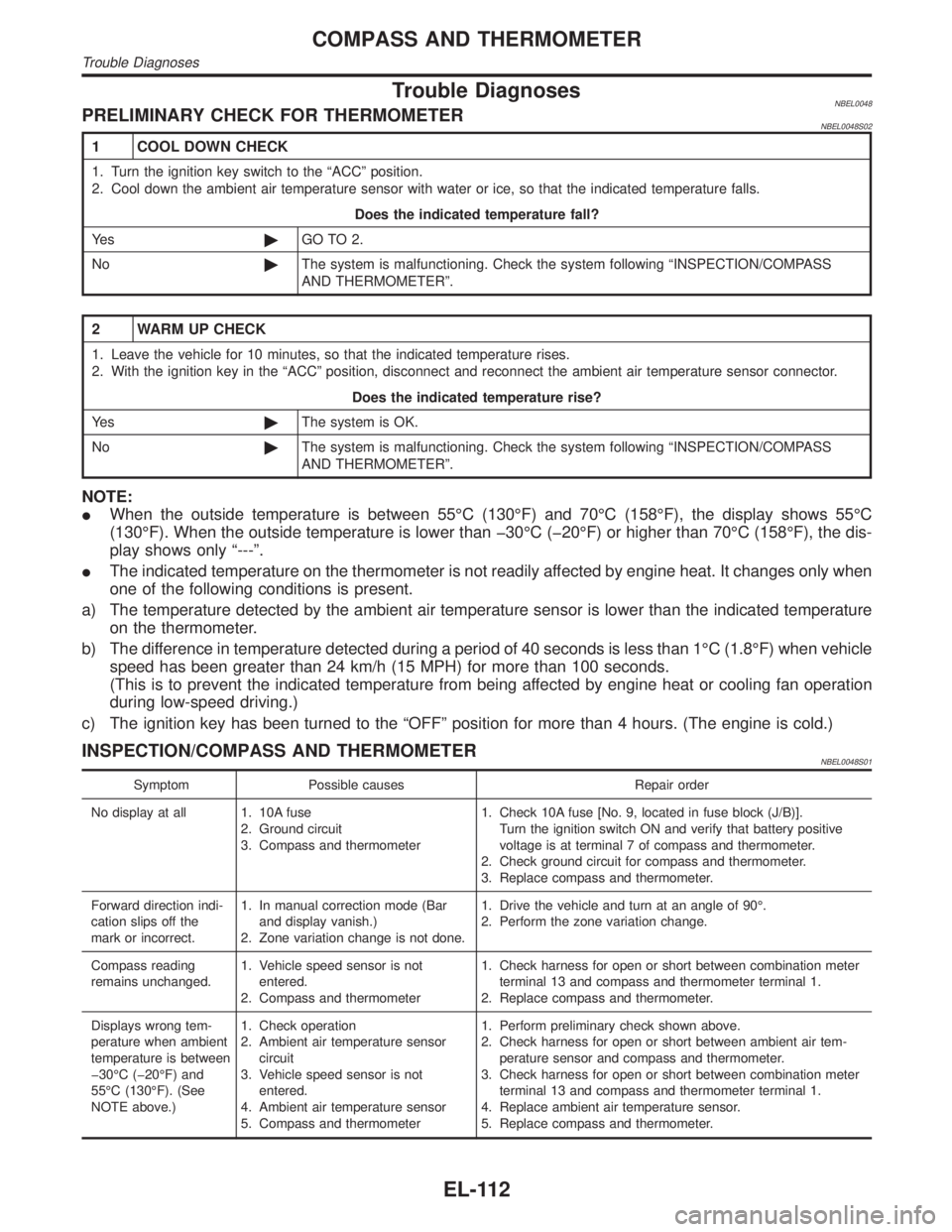
Trouble DiagnosesNBEL0048PRELIMINARY CHECK FOR THERMOMETERNBEL0048S02
1 COOL DOWN CHECK
1. Turn the ignition key switch to the ªACCº position.
2. Cool down the ambient air temperature sensor with water or ice, so that the indicated temperature falls.
Does the indicated temperature fall?
Ye s©GO TO 2.
No©The system is malfunctioning. Check the system following ªINSPECTION/COMPASS
AND THERMOMETERº.
2 WARM UP CHECK
1. Leave the vehicle for 10 minutes, so that the indicated temperature rises.
2. With the ignition key in the ªACCº position, disconnect and reconnect the ambient air temperature sensor connector.
Does the indicated temperature rise?
Ye s©The system is OK.
No©The system is malfunctioning. Check the system following ªINSPECTION/COMPASS
AND THERMOMETERº.
NOTE:
IWhen the outside temperature is between 55ÉC (130ÉF) and 70ÉC (158ÉF), the display shows 55ÉC
(130ÉF). When the outside temperature is lower than þ30ÉC (þ20ÉF) or higher than 70ÉC (158ÉF), the dis-
play shows only ª---º.
IThe indicated temperature on the thermometer is not readily affected by engine heat. It changes only when
one of the following conditions is present.
a) The temperature detected by the ambient air temperature sensor is lower than the indicated temperature
on the thermometer.
b) The difference in temperature detected during a period of 40 seconds is less than 1ÉC (1.8ÉF) when vehicle
speed has been greater than 24 km/h (15 MPH) for more than 100 seconds.
(This is to prevent the indicated temperature from being affected by engine heat or cooling fan operation
during low-speed driving.)
c) The ignition key has been turned to the ªOFFº position for more than 4 hours. (The engine is cold.)
INSPECTION/COMPASS AND THERMOMETERNBEL0048S01
Symptom Possible causes Repair order
No display at all 1. 10A fuse
2. Ground circuit
3. Compass and thermometer1. Check 10A fuse [No. 9, located in fuse block (J/B)].
Turn the ignition switch ON and verify that battery positive
voltage is at terminal 7 of compass and thermometer.
2. Check ground circuit for compass and thermometer.
3. Replace compass and thermometer.
Forward direction indi-
cation slips off the
mark or incorrect.1. In manual correction mode (Bar
and display vanish.)
2. Zone variation change is not done.1. Drive the vehicle and turn at an angle of 90É.
2. Perform the zone variation change.
Compass reading
remains unchanged.1. Vehicle speed sensor is not
entered.
2. Compass and thermometer1. Check harness for open or short between combination meter
terminal 13 and compass and thermometer terminal 1.
2. Replace compass and thermometer.
Displays wrong tem-
perature when ambient
temperature is between
þ30ÉC (þ20ÉF) and
55ÉC (130ÉF). (See
NOTE above.)1. Check operation
2. Ambient air temperature sensor
circuit
3. Vehicle speed sensor is not
entered.
4. Ambient air temperature sensor
5. Compass and thermometer1. Perform preliminary check shown above.
2. Check harness for open or short between ambient air tem-
perature sensor and compass and thermometer.
3. Check harness for open or short between combination meter
terminal 13 and compass and thermometer terminal 1.
4. Replace ambient air temperature sensor.
5. Replace compass and thermometer.
COMPASS AND THERMOMETER
Trouble Diagnoses
EL-112